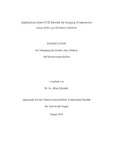Zitierlink:
http://dx.doi.org/10.25819/ubsi/640Dateien zu dieser Ressource:
| Datei | Beschreibung | Größe | Format | |
|---|---|---|---|---|
| Dissertation_Alaa_Algashi.pdf | 6.88 MB | Adobe PDF |  Öffnen/Anzeigen |
| Dokumentart: | Doctoral Thesis | Titel: | Application of pn-CCD detector for imaging of nanowires using white synchrotron radiation | AutorInn(en): | Algashi, Alaa | Institut: | Fakultät IV - Naturwissenschaftlich-Technische Fakultät | Schlagwörter: | Nanowires, pn-CCD detector, Synchrotron radiation | DDC-Sachgruppe: | 530 Physik | GHBS-Notation: | UIQN UIOS UIQD |
Erscheinungsjahr: | 2019 | Publikationsjahr: | 2020 | Zusammenfassung: | The pnCCD detector became an instrument which shows wide applications in material research. Besides white-beam Laue diffraction von single and polychrystalline materials the multilayer analysis of hard coatings and soft matter we demonstrate first application for the analysis of semiconductor nanowires (NWs). For the first time, a frame-store pn-junction CCD has been applied for structure analysis of semiconductor nanowires by means of energy-dispersive Laue diffraction using white synchrotron radiation in the energy range of 8 to 120 keV. Here a white x-ray beam exposes the sample providing a number of Laue spots which fulfill the Bragg condition for different x-ray energies. The fast and precise characterization of any materials by this method requires a simultaneous position and energy resolved detection of X-rays. The aim of this project was to investigate the real structure of different semiconductor NWs using white beam and pn CCD detector. Firstly, we present X-ray diffraction pattern taken from a periodic GaAs NW array that was grown onto GaAs[111]B surface. The experiment was performed at the home laboratory at Siegen University using a coplanar Bragg reflection. The structural properties were probed by measuring reciprocal space by quasi single shot exposure. Besides the peak related to the reflection from GaAs substrate, we found a second peak referring to the reflection from NWs. Form the difference of peak positions and peak energies the lattice mismatch between the NWs and the substrate was deduced. Secondly, a more detailed analysis was performed on InAs NWs grown onto GaAs[111]B. The experiment was carried out at the EDR beam line of BESSY II synchrotron. Energy-dispersive X-ray diffraction techniques rely on a high usable photon flux in a wide energy range (5< E< 35 KeV) so that as many Bragg peaks as possible can be detected in a single X-ray shot without any sample rotation. In addition, the usage of high-energy X-ray diffraction enables to measure a large section of reciprocal space at the same time allowing for probe the real structure of the InAs NWs and substrate GaAs and insensitive reflections simultaneously. By this experiment we could deduce the simultaneous appearance of wurtzite and zinc-blende phases in InAs NWs. Finally, we measured GaAs/InxGa1-x As/GaAs core-shell NWs grown by molecular beam epitaxy (MBE) onto a Si (111) substrate at the EDDI beamline of BESSY II. In this system, the incident x-ray beam energy ranges between 20 to 120 keV and illuminates the sample nearly parallel to the [111] direction. Due to the wide range of x-ray energies provided various Laue spots of few highly indexed {hkl} families with different lattice plane fulfill the Bragg condition simultaneous. After the evaluation the Laue spots and correction caused by the small misalignment of the incident beam with respect to [111] direction the pseudomorphic growth of the InxGa1-x As shell and the GaAs core has been verified. In summary, by using white synchrotron radiation the pnCCD provides a three dimensional intensity distribution composed by two pixel coordinates and an energy direction covering a 3D data volume in reciprocal space. In this sense, the system provides a good possibility to investigate the structure of semiconductor NWs (GaAs, InAs, GaAs/ InxGa1-x As /GaAs) because several Laue reflections can be probed simultaneous which is impossible using monochromatic radiation. Der pnCCD Detektor fand inzwischen vielfälltige Anwendungen in der Materialforschung. Neben Weißstrahl Laue Beugung von einkristallinen und polykristallinen Materialien sowie Vielfachschichten von Hartstoffen und weicher Materie demonstrieren wir hier erste Anwendungen des Detektors für die Analyse von Halbleiter Nanodrähten. Zum ersten Male wurde die energiedispersive Laue Beugung von weißer Röntgenstrahlungn und unter Nutzung einer frame-store pnCCD für die Strukturanalyse von Halbleiter Nanodrähten verwendet. Hierzu wird die Probe mit einem weißen Synchrotrostrahl im Energieintervall von 8 bis 120 keV bestrahl was einer Zahl von Laue spots führt, die die Braggbedingung für verscheidene Energien gleichzeitig erfüllt. The schnelle und genaue Charakterisierung der Matrialien mittels dieser Methode erfordert die gleichzeitige Detektion der Beugungswinkel und Beugungsenergien. Ziel dieses Projektes war die Untersuchung verschiedener Nanodrähte mittels weißer Röntgenstrahlung unter Nutzung der pnCCD. Zuerst zeigen wir die Röntgenbeugung an Arrays von GaAs NW die auf GaAs B Substraten gewachsen wurden. Das Experiment wurde im Heimatlabor der Universität Siegen in coplanarer Bragggeometrie ausgeführt. Die strukturellen Eigenschaften wurden mittels einer quasi Einzelschuß Detektion des reziproken Raumes erhalten. Neben dem GaAs Substratpeak funden wir einen zweiten Peak, der den Gas Nanodrähten zuzuordnen ist. Aus der Differenz der Beugungspositionen und Beugungsenergien wurde die Gitterfehhlanpassung beider Komponenten bestimmt. Als zweites wird über eine detilliertere Analyse von InAs NW die auf GaAs[111] B Flächen gewachsen wurden, berichtet. Das Experiment wurde an der EDR Meßstrecke bei BESSY II ausgeführt. Die enrgie-dispersive Röntgenbeugung profitierte dabei vom hohen Photoenfluß in einem weiten Energeiintervall zwischen 5 Zusammenfassend wurde dargestellt, dass unter Nutzung weißer Synchrotronstrahlung die pnCCD eine 3D Verteilung der Intensität im reziproken Raum liefert, die über zwei räumliche Achsen und einer Energieachse aufgespannt ist. In dieser Weise erlaubt das Detektiosnsystem die Erfassung der Struktur von Halbleiter-NWs (GaAs, InAs, GaAs/ InxGa1-x As /GaAs), weil viele Lauereflexe gleichzeitig erfasst warden können, was mit monochromatiscer Strahlung nicht möglich ist. |
DOI: | http://dx.doi.org/10.25819/ubsi/640 | URN: | urn:nbn:de:hbz:467-15446 | URI: | https://dspace.ub.uni-siegen.de/handle/ubsi/1544 |
| Enthalten in den Sammlungen: | Hochschulschriften |
Diese Ressource ist urheberrechtlich geschützt. |
Seitenansichten
778
checked on 01.12.2024
Download(s)
280
checked on 01.12.2024
Google ScholarTM
Prüfe
Prüfe
Alle Ressourcen in diesem Repository sind urheberrechtlich geschützt, soweit nicht anderweitig angezeigt.

